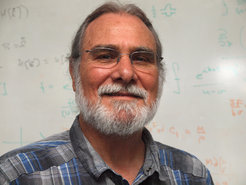Humboldt Research Prizewinner comes to IPP
US Physics Professor Philip Morrison is using the prize endowment as visiting research scientist at Garching
Physics Professor Philip J. Morrison from the renowned Institute for Fusion Studies at the University of Texas in Austin, USA, recently awarded the Siemens Prize of Humboldt Foundation, is using the research endowment as visiting scientist at Max Planck Institute for Plasma Physics (IPP) at Garching.

The prize is awarded to scientists for their overall achievement hitherto. It funds research projects selected by prizewinners themselves on which they collaborate for up to a year with colleagues in Germany. Philip Morrison is being hosted by Professor Dr. Eric Sonnendrücker, head of the Numerical Methods in Plasma Physics division at IPP.
Phil Morrison's field is mathematical and theoretical physics. He has been engaged in interdisciplinary activity in the theory of dynamical systems, fluid mechanics, e.g. in the ocean and atmosphere, and also in plasma physics and fusion research. As a long-standing member of the Institute for Fusion Studies he developed reduced theory models that nevertheless cover the essential physics of magnetically confined plasmas. “The system of equations that would exactly reproduce everything we want to know about the particle motion in magnetic fields is much too complex”, says Phil Morrison. “Even the fastest computers are much too slow to solve such a system. I am therefore working just now – in collaboration with Eric Sonnendrücker and members of his team – on simplified, but at the same time structure-conserving algorithms. These codes take into account important structures and properties of the system, e.g. momentum and energy conservation or symmetries. They should be much better for describing plasma processes such as heat transport than classical codes”, states Phil Morrison.
The frequently honoured and peripatetic physicist has been familiar with IPP for a very long time. Since his first stay at Garching in 1984 he has frequently collaborated with Garching’s plasma theoreticians. After a lengthy pause he has for some time been involved in joint projects with IPP Mathematics Professor Eric Sonnendrücker, who it was that proposed him for the Siemens Award: “During his stay at Garching we want to include work on a new code for fusion research that describes the particle motion in the plasma”, states Eric Sonnendrücker. “Phil’s innovative theory ansatz and a new numerical method developed at IPP should supplement one another very well. We hope that this will make certain processes in the plasma manageable that were hitherto too extensive for supercomputers.”
Background
The objective of fusion research is to develop a power plant favourable to the climate and environment. Like the sun it is to derive energy from fusion of atomic nuclei. As the fusion fire does not ignite till temperatures exceeding 100 million degrees, the fuel, viz. a low-density hydrogen plasma, ought not to come into contact with cold vessel walls. Confined by magnetic fields, it hovers inside a vacuum chamber, with almost no a contact.
The Carl Friedrich von Siemens Research Award is funded jointly by the Alexander von Humboldt Foundation and the Carl Friedrich von Siemens Foundation. The award is granted in recognition of a researcher’s entire achievements to date to academics whose fundamental discoveries, new theories, or insights have had a significant impact on their own discipline and who are expected to continue producing cutting-edge achievements in the future.
Isabella Milch
